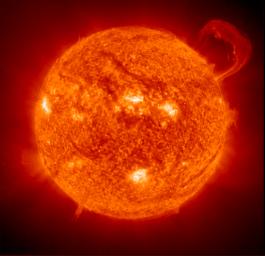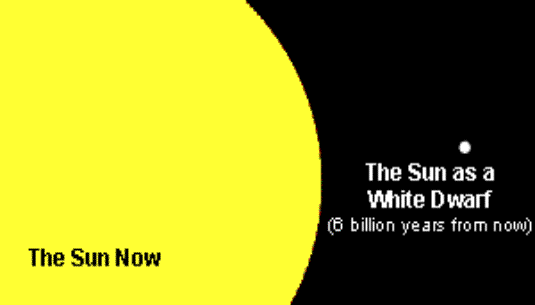Nowadays,
scientists think that there are three main hypothesis which could present a
danger for the Earth.
A)
If the sun turned into a black hole, would it suck in the earth?

The
Sun is the nearest star, its
diameter is fifty times bigger than the Earth’s one, and its mass is about 330
000 times more important.
At
the end of its life, we could think if the Sun would explode that it could
become a black hole and then represent a treat for the Earth. Don’t worry !
Even if, the Sun explodes, collapses and forms a black hole, the Earth and other
planets would continue to orbit just as they do now, because no planet would be
inside the event horizon.
Moreover,
scientists are sure that the Sun will never be a black hole. In most
circumstances, when the Sun will consume all its hydrogen it will turn into a
white dwarf. Indeed, the sun’s density is not enough important to get to the
final state which is black hole.

Finally
the White Dwarf will disperse all its heat and die becoming
a heap of dust ! So,
the probability that the Sun become a black hole and that it could swallow the
Earth is null !
Yet,
we cannot really tell if the Sun die at its end that it would not be a danger
for the Earth, because as everybody know without the Sun, the Earth cannot exist.
But, this is another problem!
B)
A black hole in the center of the Milky Way !
The second hypothesis which could be a danger for the Earth, is the black
hole located in the center of our galaxy “the Milky Way”. Indeed,
astronomers have pointed with precision the existence of a black hole, which its
center is nearby the constellation called “Sagittarius A”. The mass of this
black hole is estimated as 2,6 million times bigger than the one of the Sun, and
its diameter is about equal to the distance from Sun to Mars, 249 millions kilometers.

Yet, this galactic black hole is 25.000 light years away from the Earth.
So, there is much more mass between us and the center of the Milky Way,
which mean that the Earth is not in the Event Horizon and even in its
gravitational field, so that the black hole is insignificant in affecting the
Earth.
C)
What would happen if two supermassive black holes collapsed ?
The collision of two galaxies, which have both a supermassive black holes in their center, would provoke the merging of the two black holes.
The
Andromeda galaxy is the nearest galaxy with a galactic (supermassive) black hole.
So our Milky Way galaxy could enter in collision with Andromeda, because these
two galaxies (Milky Way and Andromeda) are approaching each other with a speed
of 300,000 miles per hour. Their collision would lead to a grand merger between
the two galaxies, and would evolve into a huge elliptical galaxy. This might
happen no sooner than ten billion years in the future.

Here
is an illustration of what the collision would be.
The
supermassive black holes in their respective centers would form a black hole of
gigantic size and density which could be a threat to our solar system, since it
would be within the event horizon of this black hole. As a matter of fact, the
Earth would be totally swallowed in one gulp.

Simulation of the merger of two black holes
On
the three analyzed assumptions, we saw that the Earth is not directly threatened
by a black hole. The only possibility for the Earth to be
absorbed by these giant monsters would suppose that the collision between
our galaxy and Andromeda occurs.